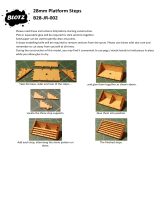Page is loading ...

28mm Loader Lifter
B28-SF-514
Please read these instructions fully before starting construction.
PVA or equivalent glue will be required to stick sections together.
Sand paper can be used to gently clean any joints.
A sharp modelling knife will be required to remove sections from the sprue. Please use knives with due care and
remember to cut away from yourself at all times.
During the construction of this model, you may find it convenient to use pegs / elastic bands to hold pieces in
place while you allow glue to dry.
Take the three pieces shown above from the sprue.
Glue them together to form a 3-layer sandwich (as
shown above) with the etched detail facing
outwards.
Take this piece.
Glue it into position.
Take these two pieces.
Glue one to each side of the assemby.
Then take these two plates.
Fix them into place.
The waist assembly is now complete.

The right leg is formed from the pieces shown above.
The left leg is the same but a mirror image.
Glue the three main pieces together wit etched
detail facing outwards.
Glue the two lower plates into place on each side of
the foot.
Take the cross piece shown above.
Glue it into the slot on the underside of the foot.
Add the upper armour plate.
(Note – this is the right leg – the left leg will have
this plate on the other side)
Glue the circular piece onto the piston rod on the back
of the lower leg.
Attach the front plate just above the foot.
Repeat the above steps to create the left leg.
Put the leg onto the waist assembly and add the upper
armour plate.
Fasten this into place by adding the “nut”.

Attach the other leg.
Take the central cog and base of the cab.
Slide the cog on top of the legs, then glue the base of
the cab into place.
The drivers chair is formed from these pieces.
Glue them together as shown.
The control console and two joysticks.
Glue the joysticks to the console.
Add the front lights.
The pieces needed to form the cab.
Glue them together as shown above.

Add the console assembly.
Glue the chair and rear cab wall into place.
Attach the walls of the cab.
The arm supports are formed from these pieces.
Glue them together, with the etched detail facing
outwards.
The back supports.
Attach these to the arm supports as shown above.
Attach this assembly to the rear of the cabs back
wall.
Each arm is formed from the pieces shown above.
Glue the pieces together with the etched detail
facing outwards.

Attach the wrist piece.
Repeat this to create the other arm.
The completed arms.
Attach the arms and fasten into place using the
shoulder cogs.
The finished model.
(Mounting on the 60mm base is optional)
Painting
We assembled our model then sprayed the whole thing with a black car undercoat aerosol.
Once that was dry we applied two rough coats yellow paint (DIY household emulsion) to the entire model.
Metal areas were painted black (model paints) then dry brushed with silver.
The rivets had a dab of gold paint put onto each of them.
The lights were painted pale blue, with a semi-circle of white added to the top left of each lens.
The edges of the seat and upper cab supports were painted dark grey, while the seat cushion was painted red.
The buttons on the console were painted a variety of bright colours.
Chips and scratches had a small patch of white painted first, then once dry a smaller patch of black was painted inside
them. Finally a dash of silver was added to inside of the black.
/











